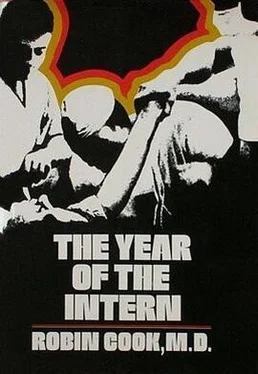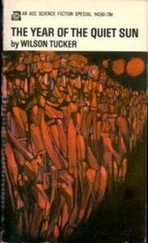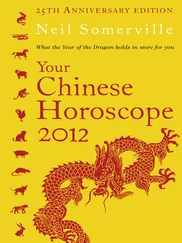Back in the eye-and-ear room, I immobilized the boy and reached into his ear, trying to grab the black object. It came apart as I pulled the forceps back, and when I looked at what came out I didn’t want to believe my eyes. It was the back leg of a cockroach. The little fellow was sobbing now as I dug out the cockroach piece by piece, feeling sorry for the boy and wanting to have it over and done with, nearly vomiting with revulsion. The last few pieces came out with a great gush of irrigation. The boy’s crying gradually subsided, and I swabbed out the ear with disinfectant. He seemed all right, but I felt pretty faint.
Throughout the last of this procedure, a nurse had been fidgeting behind me. She now informed me, somewhat icily, that Morris was still waiting down in the ortho room. Sometimes these nurses bugged me nearly to death, especially at night. I did feel a bit guilty about Morris, though, because he had been with us for almost twelve hours now, and I suppose my guilt added to my animosity toward the nurse. Being deep in sleep, Morris couldn’t have cared less. His cast was quite dry. Unfortunately, I had to wake him up in order to bind the cast to his body with an Ace bandage, and in so doing I came in for a little more verbal abuse, which seemed to me not quite up to Morris’s usual standard. What bothered me a bit was whether Morris would be able to move his shoulder, with his left arm bound so closely to his chest. But I was doing it by the book, and the clinic would ball me out on Monday if anything was amiss. Returning to the main part of the ER, I told the fidgety nurse that Morris could go home, if she could find time between coffee breaks to give him a tetanus shot.
By ten o’clock the place was really hopping, jammed full of all manner of bodily ills. With the rise in clientele, I had fallen slightly further behind, perhaps by a dozen charts. Standing quietly in the middle of the main waiting room was a woman who wanted me to examine a small puncture wound on the bridge of her nose inflicted some eight hours earlier by a pair of pruning shears. Her name was Josephs. I didn’t know why Mrs. Josephs had waited so long, but, in any case, her doctor had sent her to the ER for a tetanus injection. That was sound enough. However, the tetanus toxoid only helps the body to build immunity; furthermore, it is a slow worker. It seemed wise to supplement the tetanus shot with some premade antibodies for temporary protection, especially on a wound over eight hours old. We had just received a new shipment of a very good human-antibody serum called Hypertet, but I couldn’t give it to Mrs. Josephs without first calling her physician, a Dr. Sung, who was well known for his sharp tongue and antiquated medicine. I dialed his number with trepidation.
“Dr. Sung, this is Dr. Peters at the ER. Mrs. Josephs is here, and I am about to give her the tetanus shot, but I feel she should have something to hold her until the shot takes effect.”
“Yes, you’re right, Peters. Make it a dose of horse antitoxin, and do it quickly, please. I don’t want her to wait.”
“We have a very good human tetanus-immune globulin called Hypertet, Dr. Sung. Wouldn’t that be better than the horse serum? It’s much faster, and besides—”
“Don’t argue with me, Peters. You don’t know everything. If I wanted Hypertet, I’d order it.”
“But, Dr. Sung, if I use horse serum, there’s a chance of allergy, and I’ll have to skin-test her. All that takes time.”
“Well, what the hell are you getting paid for? Now, get on it.”
The sharp crack of the disconnection shot into my ear. Well, screw it. Old Dr. Sung was practicing very bad medicine, and someday it would catch up with him. Why should I get steamed up? Too bad about the Hypertet, though, all nicely packed and ready for injection. Ten to one the old bastard hadn’t ever heard of it. So this is what we get paid for, I thought, grimly working through a long set of directions for sensitivity testing on the side of the horse-serum bottle while fifteen people waited outside.
But I didn’t get very far with the horse serum. A siren, off in the distance, brought back the old fear. To my horror and disbelief, three ambulances pulled up simultaneously, and the crews jumped out and started unloading pieces of people, all victims of the same automobile wreck, putting them in rooms where others were already waiting. One smashed body would have been terrifying; five were simply overwhelming. While the nurses called upstairs for help from the house staff, I tried to do something, anything, before the situation immobilized me. One of the patients was a young boy with the side of his head crushed in. His breathing was extremely stertorous; at times it stopped altogether, only to resume seconds later. I started an IV, which the kid probably didn’t need right off. But he would need one eventually, and I kept busy putting it in and getting some blood for type and cross match. Inserting an endotracheal tube came next, an automatic choice. Normally a very difficult procedure for me, this one was easy because the boy’s lower jaw was so broken up that I could pull it away from his face. After sucking out his mouth and throat, bringing up bits of bone and a lot of blood, I put in the tube for him to breathe through. Surprisingly, his blood pressure was all right. I wanted to stay by the boy, even though there was nothing more for me to do for him just then, but the other patients were lying everywhere, crying for help — and, anyway, a neurosurgeon was on his way down. Later I heard that the boy had died a few minutes after leaving surgery. It bothered me for a while, until I rationalized that he had been virtually dead when I got to him.
Now, after all these months, it was easier for me not to get emotionally caught up in any one case. Other problems were waiting, demanding attention. The lady in the next room, for instance — she was critical, too. A huge area of skin and hair, running from her left ear to the top of her head, could be flapped back, revealing a network of multiple skull fractures, like a cracked hard-boiled egg ready to be peeled. The pupil on the left side was widely dilated. Where to begin? While I was looking at the skull, she suddenly vomited a pint or so of blood, which splattered off the table onto my pants and shoes. Thank goodness for the IV, providing some direction for my chaotic thoughts. I hurriedly got that going, at the same time sending up a blood sample for type and cross match to get some blood available for transfusion. Since she had vomited blood, I thought we might need eight units rather than the usual four, although her blood pressure was surprisingly strong. This matter of acceptable, even normal, blood pressure in the face of clear body failure had begun to bother me. All the books cited blood pressure as a prime and reliable indicator of general systemic function, but most of my experience seemed to be going against that rule. At any rate, I poked around at the woman’s abdomen, trying to think where that blood might have come from.
Just then a nurse urgently called me into another room, where a man was barely breathing and, she thought, convulsing. Apparently hit in the stomach, he had been one of the drivers, I guessed. The nurse handed me some amobarbital to stop the convulsing, but before I could give it I realized that instead of convulsions, he had what some call the dry heaves, a kind of retching. He vomited a little, too, not blood but a stale-smelling alcohol that also managed to splash on my shoes. When Dr. Sung called back in the midst of all this wanting to know if I had given the horse serum yet, I was tempted to unload on him, but I just said no, we were busy.
A motorcycle had been involved in the same accident. The rider was virtually skinned alive. He had abrasions all over him except on his head. He was one of the few who actually wore a helmet. Every weekend had its quota of wiped-out easy riders. For sheer gore they were unmatched — so bad, in fact, that a standard hospital joke went around about the motorcycle patient who arrived at the hospital in several ambulances. Total body bruise, fracture, and abrasion was a better description for this one. If they could talk at all, those fellows would staunchly insist that a motorcycle wasn’t so dangerous, because you got thrown free when you had an accident. But being thrown free at sixty miles an hour, onto concrete, on your head, and then getting run over didn’t leave us much to work with. This one was not only totally abraded; his left lower leg was crushed as well. The two bones were hanging out at a forty-five-degree angle, with the foot attached only by some thread of sinew. Pants, socks, bits of sneaker, and asphalt were squashed into the wound.
Читать дальше












